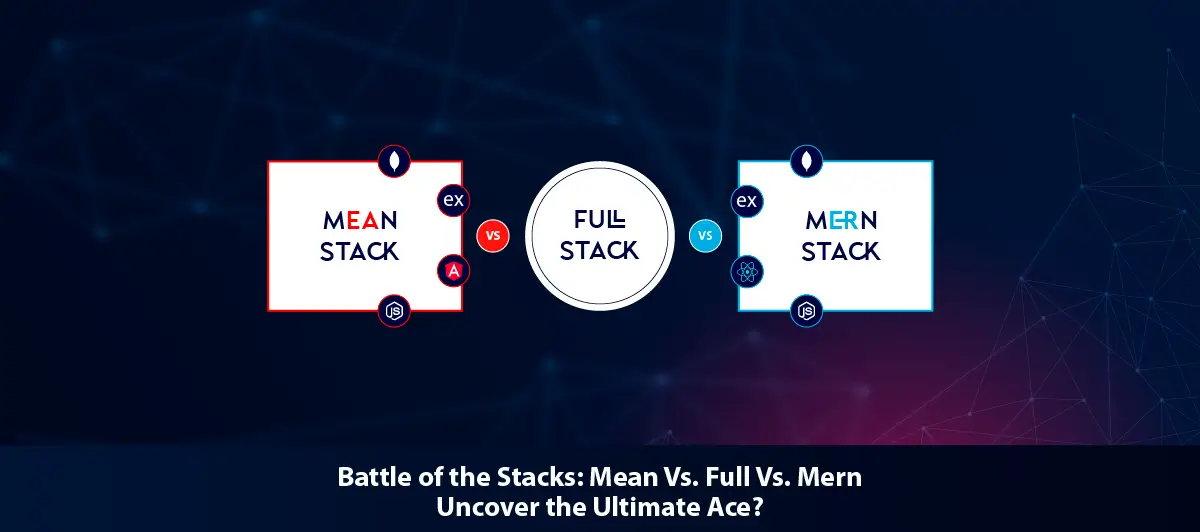Mean Stack vs. Full Stack vs. Mern Stack: Find out the best?
Quick Summary: When starting planning for software development the main thing to choose is the tech stack. So, MEAN stack vs MERN stack. We will help you to select one. As we will discuss all about these stacks, this article will help you to understand which one will be the best for you.
Introduction
When selecting a technology stack for your project, do you find yourself comparing different stacks? Developing an app requires deciding between a MEAN stack, a MERN stack, and a full stack. In the end, the decision you make determines everything from who you hire to how long it takes you to build your app and how much it costs. So, what are the major differences between MEAN stack vs Full stack vs MERN stack?
Which one should you select for your application? A key difference between MEAN and MERN stacks is that MEAN uses Angular, whereas MERN uses React JS. Angular JS provides excellent stability for maintaining abstraction in the code and managing project files. In contrast, ReactJS enables rapid code development.
Each programming language has its own advantages and disadvantages. Select the one that matches your project prerequisites. Moreover, the full stack framework contributes to design of the front-end and back-end parts. It saves time and enhances efficiency.
The MEAN stack comprises four main languages such as MongoDB, AngularJS, ExpressJS, and NodeJS. Moreover, it makes debugging procedures easier in developing applications.
The MERN stack speeds up your procedure of developing websites and applications. Javascript has been used in front-end and back-end. Furthermore, this single language has been used for various platforms such as website, mobile application, and desktop.
Let’s look at what each of these does for app development. But before we choose that, let’s understand the stack.
An overview of the stack
A “stack” is made up of several programming languages and technologies. Furthermore, Stacks are divided into two types: application stacks and technology stacks.
A technology stack is, simply put, a cross-disciplinary approach to software development.
To decide which technology stack is right for your business, you need to understand its feasibility and the features that make it suitable.
So, let’s begin and understand which among MEAN vs full stack vs MERN stack will be suitable for your application. Development.
Mean stack vs Full stack vs Mern stack: Pros and Cons
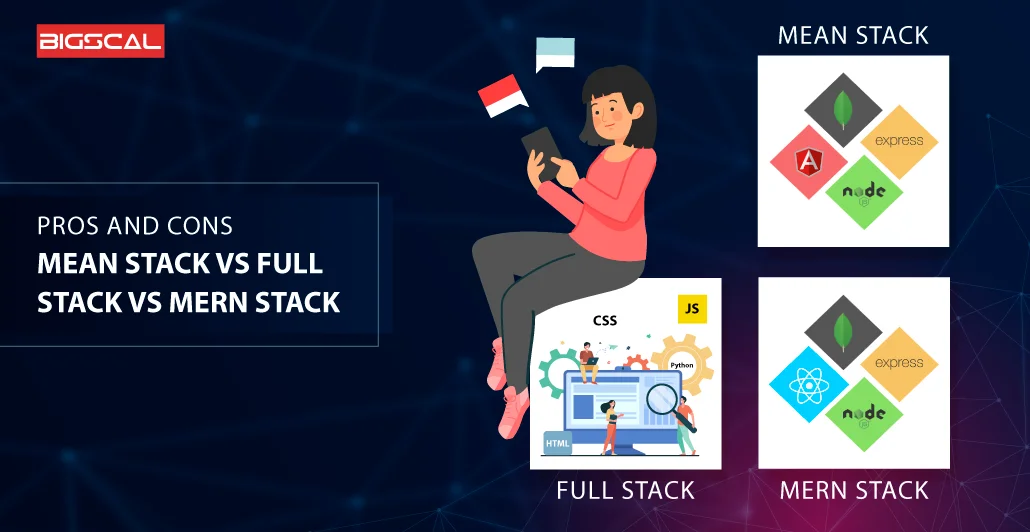
Let’s explore the pros and cons of all the tech stacks.
Full Stack
Full-stack technology combines tools and programming languages that help build front-end and back-end web applications.
Furthermore, Full-stack developers are proficient in handling backend and frontend programming languages, databases, APIs, version control systems, and servers.
Full-stack developers use various backend programming languages to create attractive UI/UX and full-featured applications.
Therefore, Businesses should hire a Hire Full Stack Developers or company, as they are skilled in building the application’s front and backends.
Pros of Full Stack
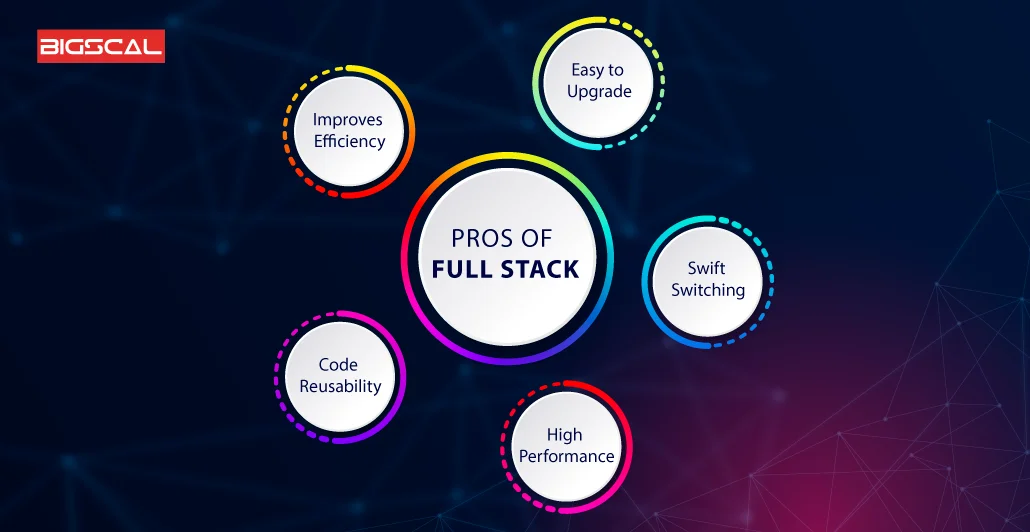
- Improves efficiency: : Full Stack developers build the front-end and back-end of the application at once. Thus, it saves a lot of time and improves the efficiency of the application development.
- Code Reusability: Developers can reuse the code of their previous application, which saves a lot of time.
- High Performance: This framework builds a high-performing application.
- Swift Switching: Full stack development allows easy switching between the front-end and back-end of the application according to project necessities.
- Easy to upgrade: You can upgrade faster with new technology and tools than people specializing in just the frontend or backend. Furthermore, there is strong community support for the full-stack development process.
Cons of Full stack
- Hard to maintain: Developers combine both the frontend and backend of the application, and it becomes challenging to update changes in it. Moreover, the developers find it difficult to coding in full stack framework because of its complicated structure, which leads to more time.
- Scalability Issues: Issues: Scaling a full-stack application can be hard because it requires managing both the front-end and back-end components to accommodate the growing user demands and ensure smooth performance.
- Increases the cost of development: With full-stack, you need to recruit a single developer for building the front-end and back-end, which is not the case with other frameworks. Therefore, it enhances the cost by 40–50% of an individual full-stack developer’s salary.
Use cases and industries where Full Stack is suitable
Small projects, MVPs (Minimum Viable Products), and startups with limited resources benefit greatly from full-stack development. Furthermore, it offers flexibility and cost-effectiveness, as only a single developer can build all aspects of the project.
Examples: Websites like Airbnb, Instagram, and Pinterest have been developed using Full Stack technology.
MEAN
MEAN (MongoDB, ExpressJS, AngularJS, and Node·js) framework has become the most favorable choice for developers in recent years. Furthermore, it allows developers to rely only on Javascript for building the front-end and back-end of the application, which streamline the development process since only one language is required. Also, it simplifies the debugging of the application.
The four components of mean stack have its unique functionalities such as Angular helps to create single page applications and websites, ExpressJS for building back-end part of website applications, MongoDB helpful for managing databases through JSON format and without use of SQL language.
Read more: Top 9 Javascript Frameworks for Front-end Development
Components of MEAN Stack
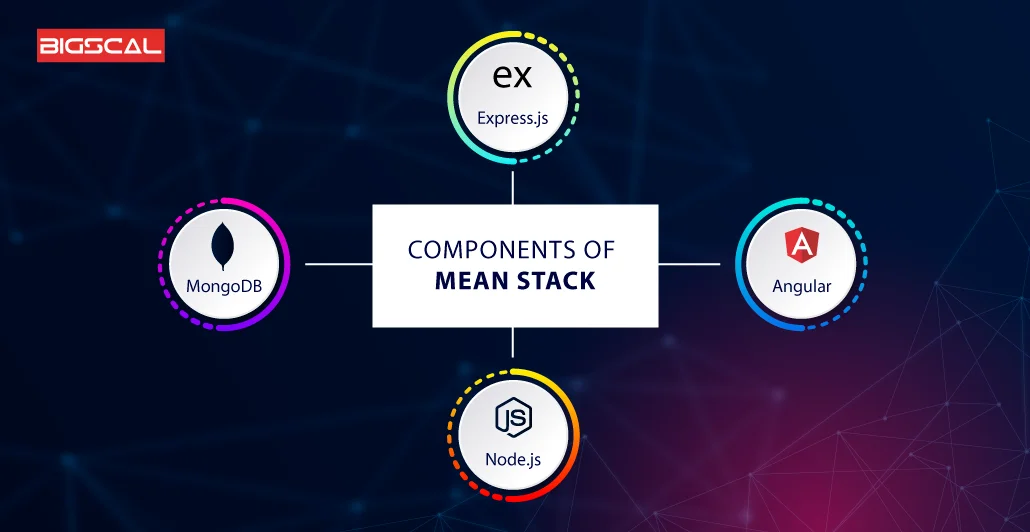
The MEAN Stack consists of the following elements:
- MongoDB: A NOSQL database that stores data in a flexible, JSON-like format.
- Express·js: A fast and minimalist web application framework for building server-side applications.
- Angular: : Angular·js is a powerful javascript framework for building dynamic single-page web applications.
- Node·js: A Javascript runtime environment that executes server-side code, allowing for scalable and efficient web applications.
Pros of MEAN stack
- Cost-Effective: Mean Stack developers are less expensive than Full-Stack as the same person is hired for two different roles (building frontend and backend)·
- Cloud compatibility: By leveraging this framework, developers can construct applications on the cloud·
- Increased efficiency: : It streamlines the development process as it involves fewer technologies and frameworks for constructing applications·
- Isomorphic coding: MEAN stack allows isomorphic coding· Therefore, developers can move code from one framework to another efficiently· Since it uses a common language for both server and client components, data can flow more smoothly between them.
- Reusability and Speed: As MEAN is based on the open-source Angular framework, developers have access to a high level of reusability, speed, and testability.
Cons of MEAN stack
- Poor Documentation: This makes it hard for beginners to work on the projects.
- Compatibility issues: Mean stack frameworks are not compatible with all types of browsers like internet explorer so it will have compatibility problems in some cases.
Use cases of MEAN
This platform is suitable for real-time web applications, social networking platforms, and collaboration tools. Furthermore, It is an ideal option for startups and small to medium-sized businesses looking for a fast and efficient development process.
Examples: Some popular applications built using MEAN Stack include PayPal, LinkedIn, and Netflix.
MERN
MERN (MongoDB, ExpressJS, React.js, and Node.js) is the latest framework, developed by a group of developers in 2015 who felt MEAN was not flexible enough for using multiple technologies.
By using this framework, you can use each component of the stack independently rather than all four at once. Furthermore, this allows you greater flexibility when working on a project that requires changes to the process of developing web apps.
Components of MERN
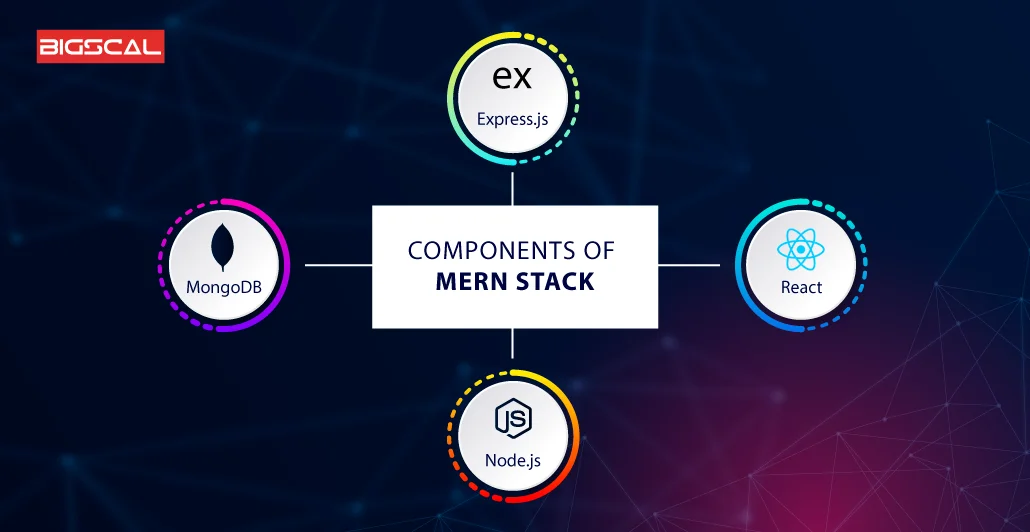
- MongoDB: a NoSQL database designed for documents.
- Express: : It’s a Node.js web framework
- React: React is an open-source frontend library written in javascript for building the UI of the application./li>
- Node.js: Allows JavaScript to run server-side using Chrome’s V8 JavaScript engine.
Pros of MERN stack
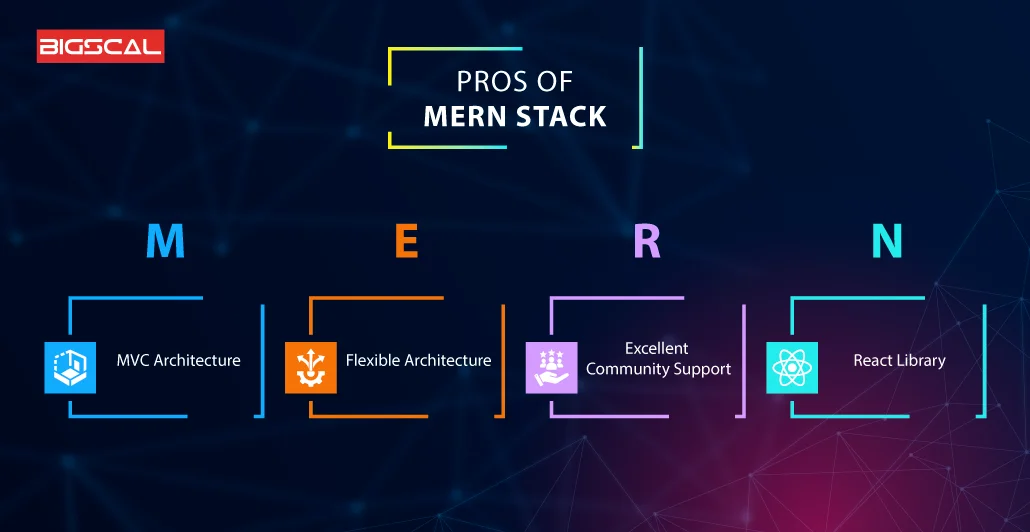
- MVC Architecture: MERN framework has MVC architecture, which helps developers to maintain and update applications faster and easier.
- Flexible Architecture: It’s easier to manage front-ends and back-ends since they can be used independently of one another, depending on the project.
- Excellent community support: MERN stack has vast and active community support. Therefore, this makes it easy for new developers to build the project.
- React Library: MERN stack includes an inbuilt React library that allows developers to leverage high-end tools that streamline the development process.
Read more: How to Choose a Web Application Architecture?
Cons of MERN stack
- Not Popular: Since the MERN stack is a new framework, it is less popular than other frameworks.
- MERN does not have an active community of developers to provide support and has poor documentation as compared to the other frameworks
Therefore, hiring a Mern stack development service can maximize the potential of Mern by utilizing its essential features and functionalities effectively.
Use cases of MERN
Mern Stack is best for building single-page applications, e-commerce platforms, and data-driven web applications. Additionally, it offers a modern and efficient development approach.
Examples: Well-known applications built using Mern Stack include Facebook, WhatsApp, and Dropbox.
MERN VS MEAN: Factors affecting your decision
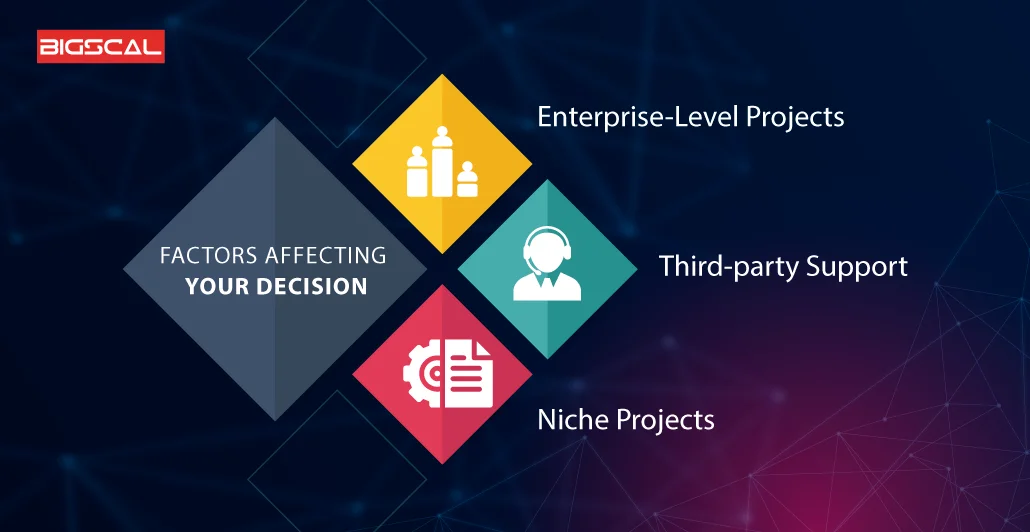
If you are striving to find out the factors to pick the best stack for building the application then, we will help to make the best decision. Read more!!!! The main difference between MEAN vs MERN is that MEAN embraces Angular and the MERN employs React. Now check out some factors that will give you clear ideas of Mern stack vs Mean stack to select the best stack for your project development
Enterprise-Level Projects
For building an enterprise-grade project, developers require a complete architecture.
Therefore, the Mean stack is best for building these projects as it is an organised framework and encloses MVC architecture.
Additionally, Mean stack helps developers to handle the coding and upgradation of the application efficiently.
Third-party Support
MEAN includes angular that provides HTTP calls and backend connection supports.
On the other hand, MERN includes React w
hich makes use of inbuilt libraries to give a more appealing look to the application.
Additionally, MEAN handles the Third-party extensions automatically but MERN developers have to do more setups.
Niche Projects
With the MERN stack, developers can make and deploy applications from scratch. Furthermore, React provides an excellent user experience and handles data changes efficiently.
Furthermore, Mern stack technology is most suitable for constructing smaller projects such as mobile apps or single-page applications.
Overall, both Mean and Mern have benefits, but no framework is flawless. Therefore, you should pick the framework according to your project requirements. Additionally, both stacks deliver different features and functionality to build an application.
The Difference Between MEAN Stack vs MERN Stack
Here you will get a clear understanding of the difference between mean stack vs mern stack and which technology you should select for your application development.
Comparison Between Three Stack Technologies
| MEAN Stack | MERN Stack | |
| Type of Framework | It is a JavaScript-based framework. | It is an open-source JavaScript library. |
| Language | While coding developers use JavaScript. | In the Mern stack, developers use JavaScript and JSON. |
| Learning Curve | The learning curve of the mean stack is hard. | Mern stack’s learning curve is easier. |
| Data Binding | It supports one-way and two-way data binding. | It only supports one-way data binding. |
| DOM | Regular DOM is supported. | Virtual DOM is supported in the Mern stack. |
MEAN stack vs Full stack vs MERN stack : Comparison Between Three Stack Technologies
Below we have compared the various factors, which will help you to understand which framework is better among Full Stack, MEAN, and MERN.
MEAN stack vs Full stack vs MERN stack: Performance
In terms of performance, MEAN and Full-Stack are similar; both perform well for websites with average traffic.
MERN, however, is better optimized for handling many different requests at once than the other two frameworks, so if your website or web app handles a lot of users at once (social media sites such as Instagram and Facebook) you should pick it over the other two frameworks.
MEAN stack vs Full stack vs MERN stack: User Experience
A full-stack framework has an inferior user experience compared to the other two frameworks.
Furthermore, using the full-stack framework can be challenging since it requires you to write extra code for Features Of Mern Stack like animations, scrolling effects, and responsive layouts.
MEAN stack vs Full stack vs MERN stack: Security
In terms of security, MEAN provides better protection from threats and vulnerabilities than Full-stack since it is written in Javascript language. However, MERN is completely a new framework so it will take more time to resolve security breaches.
MEAN stack vs Full stack vs MERN stack: Development Time
MEAN takes less time to build an application as it involves less technology than the other two frameworks.
In contrast, Full-stack and MERN technology takes more time for application development as they both utilize different technologies for creating the front-end and back-end of the application.
MEAN stack vs Full stack vs MERN stack: Ease of Use
In the MEAN stack, there are fewer concepts or technologies involved in programming. Furthermore, On the other hand, MERN and Full-Stack have complex models, which can be challenging to learn if you aren’t familiar with Javascript.
MEAN stack vs Full stack vs MERN stack: Productivity
Since only one programming language is required for all development, MEAN and MERN are more productive than Full Stack.
Furthermore, when it comes to debugging code quickly, Full Stack is easier to debug early in the development process
MEAN stack vs Full stack vs MERN stack: Community Support
In comparison to MEAN and Full-Stack, Full-Stack has been around longer and has more community support. There are active communities on all three websites, so finding help shouldn’t be an issue.
MEAN stack vs Full stack vs MERN stack: Scalability
Compared to full stack, MEAN and MERN offer more scalability since they use the same language for front-end and back-end implementations.
Furthermore, If your website or web app becomes popular quickly, however, Full Stack might be difficult to handle as it is not well-optimised for handling large loads of users simultaneously.
MEAN stack vs Full stack vs MERN stack: Features
A unique characteristic of MEAN is that it includes built-in caching, file uploads and downloads, real-time networking using Socket.IO, and authentication/authorization functionality. Furthermore, MERN provides all these features in addition to MEAN, since it was created to overcome MEAN’s shortcomings in terms of flexibility when incorporating different technologies on both the front-end and back-end sides of the website. Comparatively, Full Stack offers out-of-the-box features as well.
Full-Stack vs MEAN vs MERN: Comparison Table
Check out the comparison table of Full-stack vs MEAN stack vs MERN stack and compare the various parameters of all the tech-stacks. Furthermore, this will provide you with a clear idea of which technology will serve best for your application.
| Dimensions | Full Stack | MEAN | MERN |
| Scalability | Moderate | Better | Better |
| Productivity | Moderate-Level | Moderate- Level | Moderate-Level |
| Architecture | 3-tier web architecture. | Mean stack offers architecture to upgrade and manage the code. | Mern stack offers the architecture for smooth UI rendering. |
| Security | Full stack offers medium security for the final solution. | The mean stack provides high security for the application. | Mern stack offers medium security for the mobile application. |
| Third-Party Support | Provides various libraries, which include jQuery, LESS, etc. | Provides various different ready-to-use features | Require additional libraries for supporting similar requests |
| Features | High-Level | Moderate-Level | Moderate-Level |
Full Stack vs MEAN Stack vs MERN Stack: Which is best for your project?
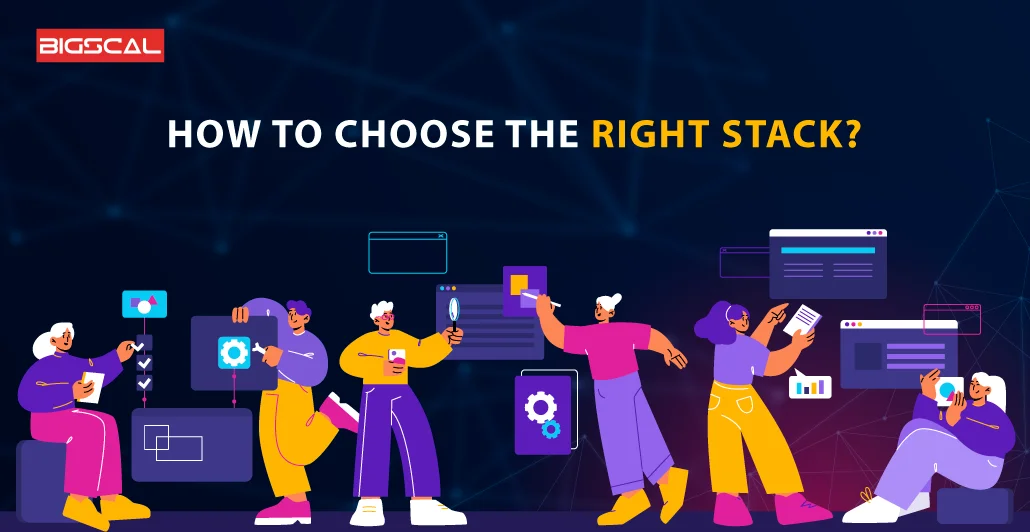
In comparison to Full Stack, MERN, and MEAN, MEAN is the best framework. Compared to Full Stack, it offers several advantages in performance, security, development time, ease of use, community support, and scalability. In terms of user experience and productivity, it is on par with MERN since both use a single programming language for front-ends and back-ends.
Conclusion
Full-Stack offers a general platform to build any type of application. MEAN and MERN are specific back-end technologies with different performance and scalability strengths.
If you want the best technology for your project, it’s good to hire a top MEAN stack development service.
Bigscal is a best-in-class MEAN stack development company. We provide skilled app developers who will work exclusively on your project. We will ensure you get the best results for your next project.
To scale your app and add more functionality, you can hire a full-stack developer. You can hire Mean developers to upgrade your current application and add the latest libraries. The last option is to hire Mern developers to integrate third-party libraries into your application, which will provide smooth UI rendering
FAQ
When to pick MERN Stack for application development?
When you need to develop software with simple functionality, MERN is the best option. Additionally, the stack can be used for mobile development as well as enterprise projects.
Which is better: MEAN Stack or MERN Stack?
Angular js’ vertical learning curve makes MERN a preferred stack over MEAN. Furthermore, as these technology stacks are essential to the development of web and mobile applications of any kind, you should choose one based on your budget and project requirements.
Is MERN stack in demand?
Yes, the MERN stack is still in high demand as it offers a powerful combination of technologies for building web applications.
How do you choose a tech stack?
Choosing a tech stack involves considering factors like project requirement, scalability, team expertise, community support and future growth potential. Furthermore, evaluate frameworks, programming languages, libraries and databases that best align with your project needs.
When should you avoid choosing MERN Stack for your project?
There is no complexity involved in implementing the MERN stack because it is lightweight. Furthermore, it is recommended not to use this tech stack for web development projects that require complex functionality.
